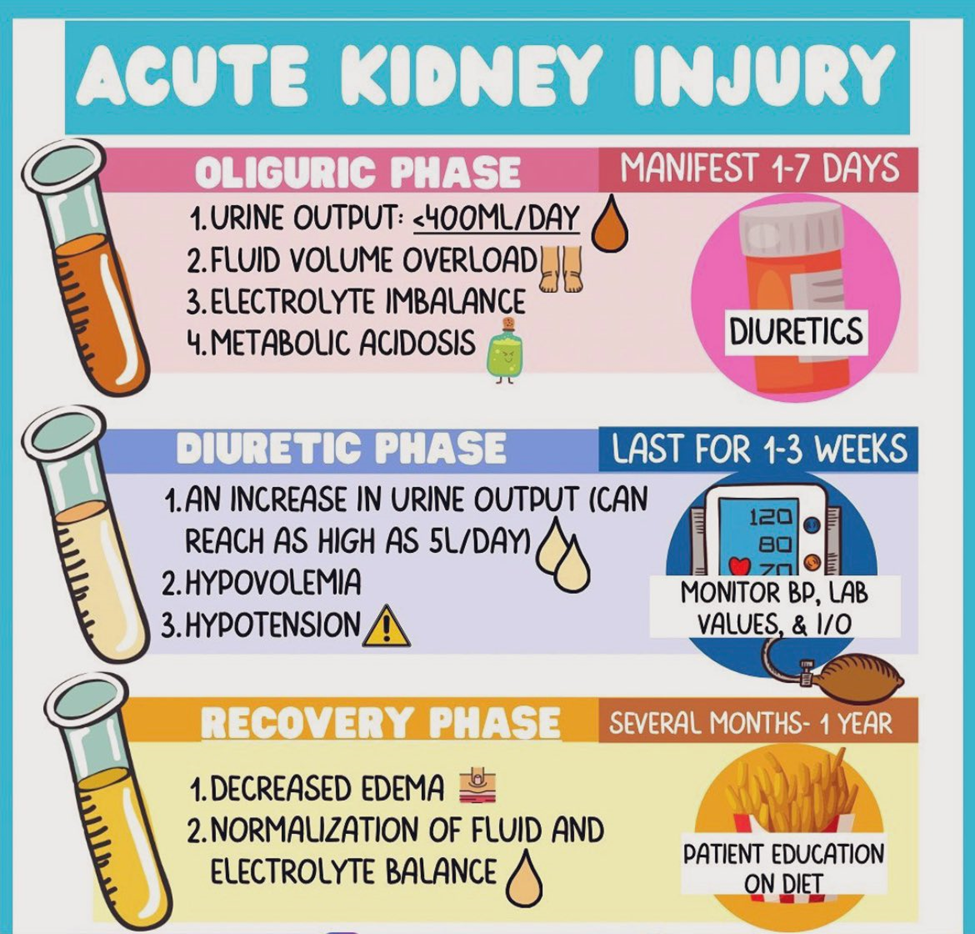A client who has developed acute kidney injury (AKI) due to an aminoglycoside antibiotic has moved from the oliguric phase to the diuretic phase of AKI Which parameters are most important for the nurse to plan to carefully monitor?
Hypovolemia and electrocardiographic (ECG) changes.
Uremic irritation of mucous membranes and skin surfaces.
Side effects of total parental nutrition (TPN) and Intralipids.
Elevated creatinine and blood urea nitrogen (BUN)
The Correct Answer is A
A. Hypovolemia and electrocardiographic (ECG) changes:
During the diuretic phase of AKI, there is an increased urine output, and the risk of dehydration and hypovolemia is elevated. The nurse should closely monitor fluid balance to prevent dehydration, and ECG changes may occur due to electrolyte imbalances (such as hypokalemia) associated with diuresis.
B. Uremic irritation of mucous membranes and skin surfaces:
Uremic symptoms are more prominent in the oliguric phase of AKI when waste products accumulate in the blood. In the diuretic phase, the focus shifts more toward managing fluid and electrolyte balance.
C. Side effects of total parental nutrition (TPN) and Intralipids:
TPN and Intralipids are not directly related to the diuretic phase of AKI. Monitoring for side effects of TPN and Intralipids may be relevant in other clinical contexts but is not the primary concern in the diuretic phase.
D. Elevated creatinine and blood urea nitrogen (BUN):
Monitoring creatinine and BUN levels is important for assessing kidney function, but in the diuretic phase, the focus shifts to managing fluid and electrolyte balance. The risk of hypovolemia and electrolyte imbalances is more immediate during this phase.

Nursing Test Bank
Naxlex Comprehensive Predictor Exams
Related Questions
Correct Answer is D
Explanation
A. Eat a diet high in carotene:
While a healthy diet is important for overall well-being, there is no evidence to suggest that a diet high in carotene specifically prevents or treats glaucoma. The focus in glaucoma management is on intraocular pressure control.
B. Wear prescription glasses:
Prescription glasses may be beneficial for addressing refractive errors, but they do not specifically address the management of glaucoma. The client's concern about driving through a tunnel is more likely related to changes in peripheral vision associated with glaucoma.
C. Avoid frequent eye pressure measurements:
This is not the most important instruction. Monitoring intraocular pressure is a crucial aspect of glaucoma management, and the frequency of measurements is determined by the healthcare provider. Regular monitoring helps assess the effectiveness of treatment and disease progression.
D. Maintain the prescribed eye drop regimen:
This is the correct answer. The most important instruction for the client is to adhere to the prescribed eye drop regimen. Medications, often in the form of eye drops, are commonly used to lower intraocular pressure and manage glaucoma. Consistent use of prescribed medications is critical for controlling the condition and preventing further vision loss.

Correct Answer is D
Explanation
A. Initiate cardiac telemetry:
Cardiac telemetry is not the immediate priority in this case. Kidney stones are more likely to cause severe localized pain rather than cardiac-related symptoms.
B. Administer a PRN dose of a laxative:
Laxatives are not indicated for the management of kidney stones or the associated flank pain. The priority is to address the specific needs related to the possible passage of kidney stones.
C. Implement seizure precautions:
Seizure precautions are not relevant to the sudden onset of severe flank pain in the context of hyperparathyroidism. The focus should be on managing pain, assessing for kidney stone passage, and addressing the underlying cause.
D. Begin straining all urine.
Straining all urine allows for the collection and examination of any passed stones. This information is important for identifying the composition of the stones and guiding further management.

Whether you are a student looking to ace your exams or a practicing nurse seeking to enhance your expertise , our nursing education contents will empower you with the confidence and competence to make a difference in the lives of patients and become a respected leader in the healthcare field.
Visit Naxlex, invest in your future and unlock endless possibilities with our unparalleled nursing education contents today
Report Wrong Answer on the Current Question
Do you disagree with the answer? If yes, what is your expected answer? Explain.
Kindly be descriptive with the issue you are facing.
